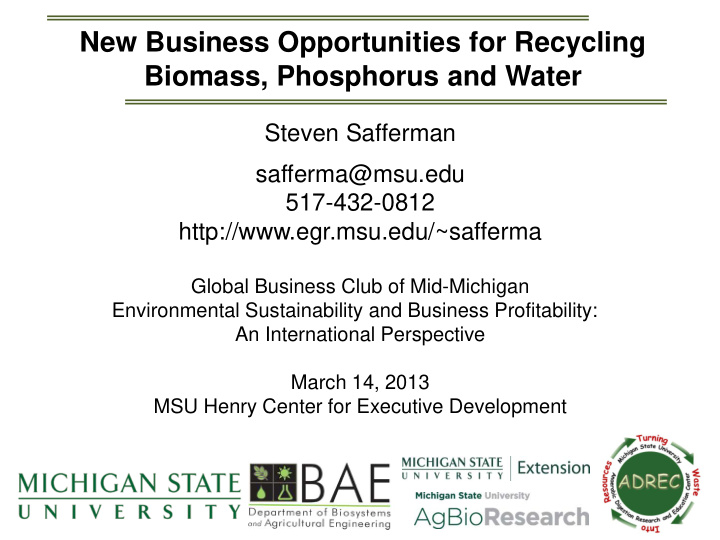



New Business Opportunities for Recycling Biomass, Phosphorus and Water Steven Safferman safferma@msu.edu 517-432-0812 http://www.egr.msu.edu/~safferma Global Business Club of Mid-Michigan Environmental Sustainability and Business Profitability: An International Perspective March 14, 2013 MSU Henry Center for Executive Development
Contents Challenges in the Global Environment Evolution of Waste Management Challenges = Opportunities Why Agriculture? Wastewater Irrigation Anaerobic Digestion Phosphorus Treatment and Recovery
Challenges in the Global Environment • World population in 2012: 6.9 billion; projected in 2030: 8.3 billion 1 • Water projected needs in 2030: 30% increase 2 • Energy projected needs in 2030: 40% increase 2 • Food projected needs in 2030: 50% increase 2 • Water quality resulting in premature deaths: 1,700,000/year 3 • World population suffering from waterborne diseases or shortages: 50% 4 • Air quality resulting in premature deaths: 800,000/year 3 1 United Nations World Water Assessment Program. http://unesco.org/images/021/002154/215492a.pdf 2 The Water-Food-Energy Live Debates, The Guardian, www.guardian.co.uk/sustainable-business/nexusthinking-global- water-food-energy 3 Organization of Economic Co-Operation and Development http://www.oecd.org/els/health-systems/40396531.pdf 4 Our Planet, Our Health, Report by WHO Commission on Health and Environment http://www.ciesin.or/docs1001-012/001-012.htm
Evolution of Waste Management From: Pollution Prevention: Fundamentals and Practice, Bishop,2000
Evolution of Waste Management Raw Material Environment Waste Material Product
Challenges = Opportunities Wastes = Resources Wastes Resources Food production wastewater to grow commodities Energy production from organic wastes Nutrients from wastewater http://www.norganics.com/products/fe rtilizers/phosphate-rock.html
Why Agriculture Amount of fresh water required by agriculture: 70% 1 • Required water for a pound of rice: 3,500 L; for beef: 15,000 L 1 • Increase in phosphorus use since1960: doubled 2 • Global estimated phosphorus reserves: 35 years 3 • • Phosphorus reserves: 90% in Morocco, Jordan, S. Africa, US, China 3 1 United Nations World Water Assessment Program . http://unesco.org/images/021/002154/215492a.pdf 2 USDA Soil Quality Institute Technical Pamphlet 2, Phosphorous in Agriculture. http://soils.usda.gov/sgi/publications/files/prole.pdf 3 Does Peak Phosphorous Loom? American Scientist, 2010, 98(4):291
Wastewater Irrigation Food Processing Wastewater • Efficient treatment • Commodity production • Water • Nutrients • Aquifer recharge • Effective treatment?
Improper Wastewater Disposal Detroit Free Press, 8/10/2009 (http://www.freep.com/uploads/pdfs/2009/08/0809%20GROUNDWATER%20dp.pdf)
Improper Wastewater Disposal Detroit Free Press, 8/10/2009 (http://www.freep.com/uploads/pdfs/2009/08/0809%20GROUNDWATER%20dp.pdf)
Improper Wastewater Disposal Metal Mobilization Food processing wastewater • • Domestic wastewater infiltration basins Manure land applied to crops • • Bioremediation of hazardous waste • Filter strips for agricultural runoff Filter beds for milking facility wastewater • Surface Water Impacts
Wastewater Irrigation Design Criteria For food processing waste, Organic loading: 40 to 1800 lb BOD/acre/day Hydraulic loading: 2,700 to 16,000 gal/acre/day Little justification for these loadings and no coherent irrigation strategies that minimize environmental harm and maximize loadings. http://www.egr.msu.edu/~safferma/Research/Greeen/Deliverables/Assimilation%20Capacity%2012-8-2007.pdf MSU Research Program • Laboratory column – prescriptive values • Field monitoring
MSU Wastewater Irrigation Research
MSU Wastewater Irrigation Research
MSU Wastewater Irrigation Research Cluster 1 Cluster 2
Anaerobic Degradation What does carbon look like in manure and food processing waste? C a H b O c ? d ? e ? f ? g ? h Photo Credit: Andrew Wedel, McLanahan Corp. What does carbon look like in energy? H CH CH 4 H H C H
Landfills v. Anaerobic Digestion
Anaerobic Digestion Pathogen reduction Environmental Benefits Nuisance avoidance Greenhouse gas reduction Heat Electricity CH 4 (50 – 60%) Natural gas Biogas CO 2 (40 – 50%) Flare Other? (Trace) Bioproducts Fiber Water Nutrients
Anaerobic Digestion Costs/Revenues Costs Revenues • Management • Electricity • Capital • Heat • Materials • Carbon credit Handling • Renewable energy credits • Digesters • Tipping fees • Interconnections • Fiber • Generator • Difficult to quantify • Pathogen reduction Operations • • Nuisance avoidance • Nutrient management
Anaerobic Digestion Pipeline Vehicles Natural Gas Methane Combined Heat & CO 2 Biogas Power System Green House Agricultural Anaerobic Vegetable Heat Residues Digester Production Liquid/Fiber Liquid Algal Culture Separator Stream Animal Fish Fiber Crop Biodiesel Feed Meal Production Aquaculture Source: Wei Liao, MSU Dept. of Biosystems Engineering
MSU Anaerobic Digestion Research Anaerobic Digestion Research and Education Center
MSU Anaerobic Digestion Research Continuum of Anaerobic Digestion Research • Locating Feedstocks • Modeling • Biogas Methane Potential • Design and Cost Testing • Logistics • Basic and Applied Research
Phosphorus - Impact Grand Lake St. Marys http://www.lakescientist.com/2010/toxic-algae-continues-to- defile-water-quality-in-the-buckeye-state http://www.ohiotraveler.com/popular_ohio_parks.htm http://www.daytondailynews.com/news/news/lo Drakejournal.com cal/algae-chokes-off-lakes-life-regions- http://www.darkejournal.com/2010/06/yuk-some-photos-of-grand-lake-st-marys.html livelihood/nNFBH/
Phosphorus - Sources
Phosphorus Treatment and Recovery Sorption Iron oxides Aluminum oxides Phosphate metal complex Calcium oxides • Multiple charged cations to attract phosphates • Form surface hydroxides that can exchange with phosphates • Form mineral complexes with orthophosphate
Phosphorus Treatment and Recovery Media Nano Enhanced Iron Foam Alcan Activated Alumina (Al 2 O 3 ) AA400G, Mesh Size 14X28
Phosphorus Treatment and Recovery Nano Enhanced Iron Foam • Material: iron oxyhydroxide nano fibers grown on zero-valent iron foam • Porosity: 80% • Shape: granular or formed • Pore size: 100-200 micron • Surface area 60 - 100 m 2 /g (non porous media: 1 – 2 m 2 /g) MetaMateria Technologies, LLC, Publicity Materials
Phosphorus Treatment and Recovery Nano Enhanced Iron Foam MetaMateria Technologies, LLC, Publicity Materials
MSU Phosphorus Research
MSU Phosphorus Research • Nano iron coated iron foam, 2 mg/L breakthrough (450 days): 40–150 mg P/g • Activated aluminum A400g: 16.0 mg P/g • Activated aluminum A400g, 2mg/L breakthrough (10 days): 10.5 mg P/g • Cotton based media coated with iron: 8.9–19.0 mg P/g* • Natural based media with Fe and Al oxides and kaloinite: 2.1 mg P/g* • Natural soils and sediments: 0.0063 –0.501 mg P/g** *Enhanced Adsorption and Regeneration with Lignocelluloses-Based Phosphorus Removal Media Using Molecular Coating Nanotechnology, Kim et al., Journal of Environmental Science, Part A, 41, 2006, pp. 87-100. **Laboratory Development of Permeable Reactive mixtures for the Removal of Phosphorus from Onsite Wastewater Disposal Systems, Baker et al., Environmental Science Technology, 32, 15, 1998, pp. 2308-2316.
Opportunities? Steven Safferman safferma@msu.edu 517-432-0812 www.egr.msu.edu/~safferma/
Recommend
More recommend